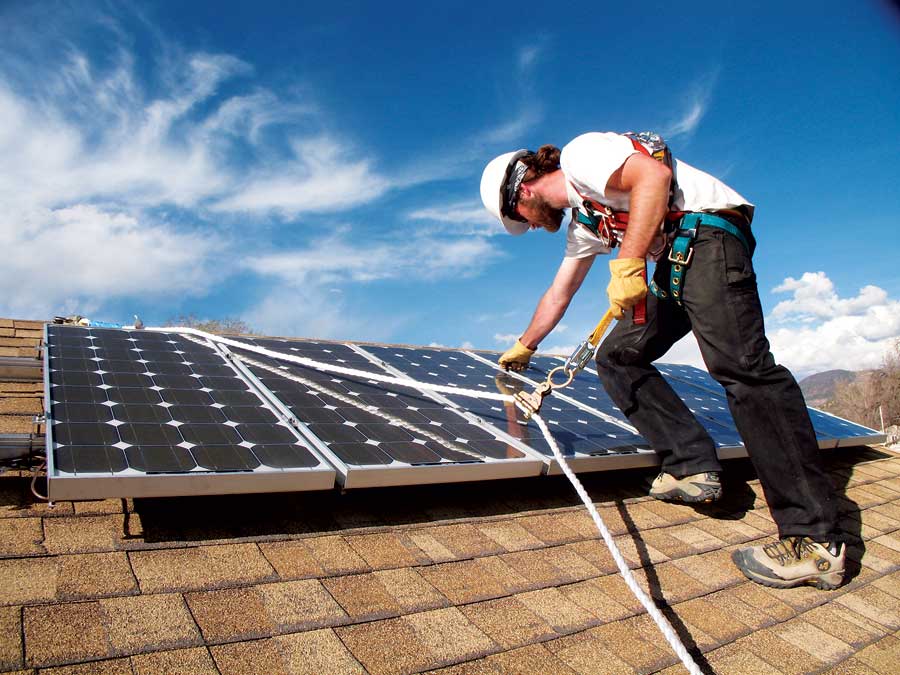Integrating solar panels into architecture is a reality that we can already find in many recently built buildings. However, it is also possible to carry it out in buildings already built later after renovating or implementing the necessary measures so that they can be part of the home’s design.
Integrating solar panels into buildings offers us many advantages, firstly because the result is much more aesthetic and functional and, secondly, because it allows us to take advantage of photovoltaic energy in any building. Since they can be integrated into any space. If you thinking about installing solar panels in your home, read on to learn more about this modern trend and how to do it.
What is the integration of solar panels in architecture?
Many aspects have changed in modern architecture, mainly because it has become much more aesthetic and functional, adapting to the urban and rural landscape also because it responds to the daily needs of users and the design of inclusive public spaces and, of course, because it takes the environmental impact into account.
Several methods and strategies are implemented to achieve this goal, and the integration of solar panels is one of them. These, as you know — and I have explained on several occasions — reduce the consumption of fossil fuels since they allow us to achieve partial or absolute independence from the general electrical grid — the latter in the case of isolated solar installations. In addition, clean and renewable energy is generated.
Is the installation of solar panels mandatory in newly built homes?
In my opinion, the installation of solar panels will be mandatory from 2029 for government or public buildings since they must be emission-free to comply with regulations on environmental matters. This measure will also be applied compulsorily to newly built buildings and homes in 2030 so that in less than a decade, we will see how solar panels are integrated into all of them. This will increase the prices of solar panels in the market.
Ways to integrate solar panels into architecture
As I indicated above, integrating solar panels in architecture has many advantages, from a better aesthetic and functional result to the possible use of solar panels in any situation.
The integration of solar panels also reduces the visual impact on the environment. Currently, there are several ways to integrate solar panels, although it is most advisable to have the vision of an architect who can advise you on the process. I see it:
Architectural integration of solar panels according to their materials and characteristics
The first thing we must consider is the type of solar panel or material with which it has been manufactured — since the characteristics of one or the other give way to one type of integration.
These are:
- Traditional monocrystalline and polycrystalline panels: Both are made of silicon (conductive material). However, the first of them is manufactured by cutting the silicon ingots into sheets and rounding their edges (it is purer and offers more excellent performance), and the polycrystalline, which is raw silicon, is melted without removing impurities and poured into a square mold to give rise to polycrystals (its efficiency is slightly lower, but its price is more affordable).
- Thin film solar panels: Also known as Thin Film solar panels (TFPV), which are cheaper, remain efficient, and have the particularity of their great flexibility, which allows us to install them more efficiently and in many other places, such as facades. , as you can read here.
Architectural integration according to the aesthetics of solar panels
Of course, apart from the materials and characteristics each offers, we must also consider their aesthetics and the final result at the installation site.
In this case, we must consider aspects such as the color of the cells (which can be blue or black), the frame (which can be black or silver), the back sheet (which is where the cells are placed and can be white or black) and finally the wiring(which is most advisable for it to be hidden within the panel to achieve greater integration into the architecture).
Regarding the color of the cells and the frame, you can also opt for several combinations that aesthetically look very good, depending — above all, on the color of the facade and the chromatic range of colors.
The location of the solar panel in architecture
The integration of solar panels will help you make them part of the structure of the building, taking advantage of solar energy to generate electricity and having a very positive impact on the aesthetic and functional design of the project.
And their location is something that considerably influences that last point. There are several places where they can be integrated. These are:
- Solar panels on roofs, roofs, or rooftops: It is the most common and recommended form, although it is not always possible. They can be mounted inclined (to maximize solar energy collection) or horizontally (flat).
- Solar panels on facades: As a covering of the building. They are usually transparent or semi-transparent solar panels that allow natural light to pass through them.
- Solar window panels: These replace windows and are transparent, allowing light to pass through them while capturing energy.
- Solar panels on awnings, canopies, and other covers: This is another common place where they are usually installed, especially in parking areas or outdoor terraces, as well as in pergolas and sheds.
In any case, it is most advisable to consider solar energy from the early stages of building design to simplify the process and guarantee aesthetics and functionality.

